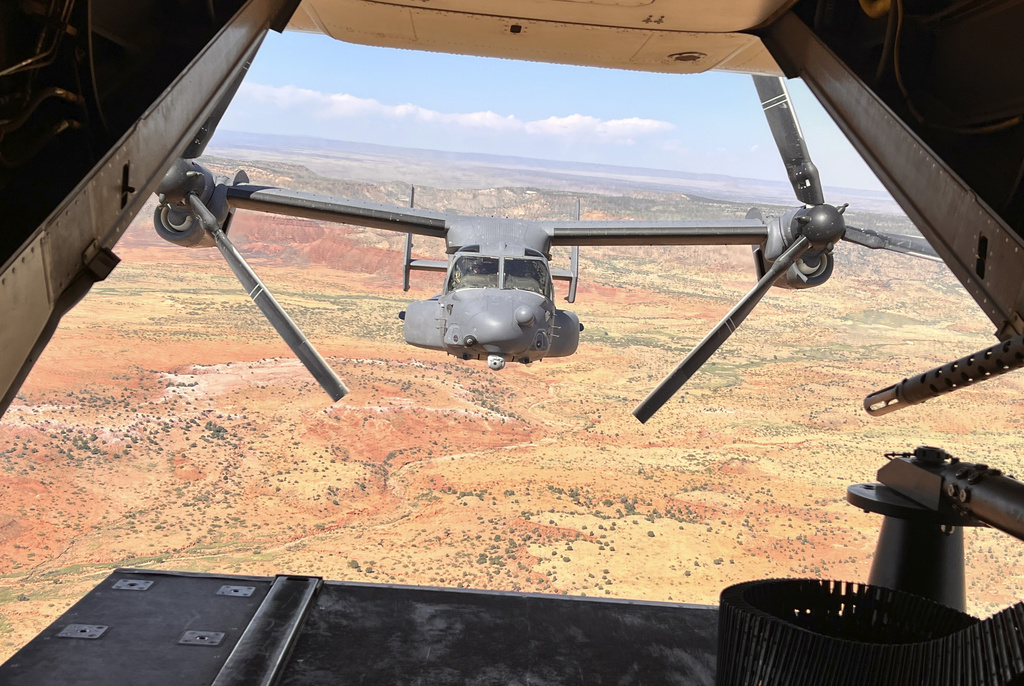Lawmakers Urge Pentagon to Ground V-22 Ospreys \ Newslooks \ Washington DC \ Mary Sidiqi \ Evening Edition \ Three Massachusetts lawmakers urged Defense Secretary Lloyd Austin to ground the V-22 Osprey fleet due to persistent safety and design issues revealed by an Associated Press investigation. The aircraft has been involved in over 21 major accidents, some tied to its design flaws, including its “interim power” feature. The Pentagon has yet to respond to the lawmakers’ concerns, as debates over the Osprey’s safety and operational future continue.

Lawmakers Push for Grounding of V-22 Ospreys: Quick Looks
- Congressional Appeal: Sens. Warren, Markey, and Rep. Neal called for a halt to V-22 operations.
- Safety Record: Over 21 major accidents tied to design flaws plague the Osprey.
- Recent Crashes: Grounded in 2023 after a deadly crash in Japan, operations have resumed with restrictions.
- Interim Power Concerns: The feature, essential for safe landings, wears down components and contributed to a recent crash.
- Pilot Opposition: Some Osprey pilots oppose grounding, citing the aircraft’s unique mission capabilities.
- Pentagon Silence: The Defense Department has not commented on the lawmakers’ letter or investigation findings.
Deep Look
The Lawmakers’ Letter
In their letter, the lawmakers stressed the urgency of addressing safety concerns surrounding the V-22 Osprey. “Given the current concerns about the safety of the V-22, the aircraft should be grounded, and should not be deployed again until the platform’s significant deficiencies are fully addressed,” the letter stated.
The V-22 Osprey is a tiltrotor aircraft capable of vertical takeoffs like a helicopter and fast, long-distance flights like a fixed-wing airplane. While its versatility makes it a critical asset for the military, its accident history has raised serious safety questions.
A Troubled Safety Record
The fleet was grounded for three months in 2023 after a crash in Japan that claimed the lives of eight service members. Despite this pause in operations, the Ospreys returned to service with certain restrictions in place. However, concerns remain unresolved, as highlighted by another recent crash in October 2024 involving a Japanese self-defense forces Osprey. That incident occurred when pilots failed to engage the aircraft’s “interim power” feature during takeoff, leading to a violent tilt and ground strike.
Interim Power: A Critical but Controversial Feature
A key focus of criticism is the Osprey’s “interim power” feature, which provides extra engine power during critical moments like takeoff and landing. While this feature can prevent accidents, it also accelerates wear on the aircraft’s components, leading to maintenance challenges. Pilots face a difficult choice: rely on interim power to enhance safety during demanding maneuvers or avoid it to prevent long-term damage to the aircraft.
“The reality for pilots is that they have to push the aircraft to its limits to stay safe,” Warren, Markey, and Neal wrote in their letter, highlighting the precarious balance between operational necessity and safety risks.
Pilot and Program Officials’ Perspectives
Despite the safety concerns, many Osprey pilots remain opposed to grounding the aircraft. They argue that the Osprey’s unique capabilities are irreplaceable for critical missions, such as troop transport and presidential fleet operations.
Program officials have echoed these sentiments, emphasizing that efforts are underway to improve the V-22’s safety and reliability. However, progress has been slow, and the aircraft’s accident record continues to overshadow these assurances.
Pentagon’s Response Awaited
Wider Implications for Military Aviation
The debate over the V-22 Osprey is emblematic of broader challenges in military aviation, where cutting-edge technology often comes with increased risks. The tiltrotor design, while innovative, has proven difficult to perfect, and the consequences of its shortcomings have been devastating.
For the lawmakers and safety advocates pushing for change, the grounding of the fleet represents a necessary step to prevent further loss of life. For the Pentagon and military leadership, however, grounding the Ospreys could mean compromising mission readiness in situations where no other aircraft can perform as effectively.
Future of the V-22 Osprey Program
However, without meaningful improvements to address safety concerns, the Osprey’s reputation—and its operational viability—will remain under intense scrutiny. For now, the lawmakers’ appeal underscores a growing demand for accountability and a clear path forward to ensure the safety of service members who rely on the V-22.
Lawmakers Urge Pentagon Lawmakers Urge Pentagon







